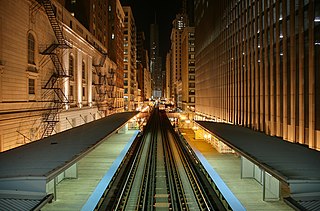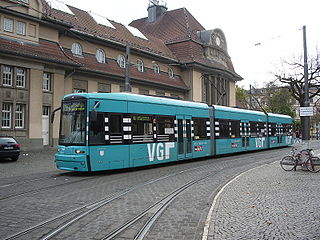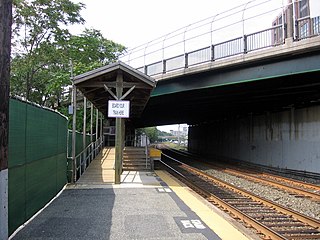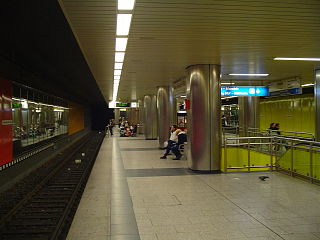
Light rail transit (LRT) is a form of passenger urban rail transit characterized by a combination of tram and rapid transit features. While its rolling stock is similar to that of a traditional tram, it operates at a higher capacity and speed and often on an exclusive right-of-way. In many cities, light rail transit systems more closely resemble, and are therefore indistinguishable from, traditional underground or at-grade subways and heavy-rail metros.

A bilevel car or double-decker coach is a type of rail car that has two levels of passenger accommodation as opposed to one, increasing passenger capacity.

The SD-100 and SD-160 are light rail vehicles (LRV) that were manufactured by Siemens Mobility between 1992 and 2013 for the North American market. The vehicles were all constructed at the Siemens facility in Florin, California.

The Massachusetts Bay Transportation Authority (MBTA) system is mostly but not fully accessible. Like most American mass transit systems, much of the MBTA subway and commuter rail were built before wheelchair access became a requirement under the Americans with Disabilities Act of 1990. The MBTA has renovated most stations to be compliant with the ADA, and all stations built since 1990 are accessible. The MBTA also has a paratransit program, The Ride, which provides accessible vehicles to transport passengers who cannot use the fixed-route system.

A low-floor tram is a tram that has no stairsteps between one or more entrances and part or all of the passenger cabin. The low-floor design improves the accessibility of the tram for the public, and also may provide larger windows and more airspace.

A low-floor bus is a bus or trolleybus that has no steps between the ground and the floor of the bus at one or more entrances, and low floor for part or all of the passenger cabin. A bus with a partial low floor may also be referred to as a low-entry bus or seldom a flat-floor bus in some locations.

Bucharest has the largest transport network in Romania, and one of the largest in Europe. The Bucharest transport network is made up of a subway network and a ground transport network. Although there are multiple connection points, the two systems operate independently of each other, and are run by different organisations (the subway is run by Metrorex and the ground transport network by Societatea de Transport București. The two companies used separate ticketing systems until 2021, when a new smartcard was introduced alongside the old tickets, which allows travel on both the STB and the Underground.

Urban rail transit is a wide term for various types of local rail systems providing passenger service within and around urban or suburban areas. The set of urban rail systems can be roughly subdivided into the following categories, which sometimes overlap because some systems or lines have aspects of multiple types.
Various terms are used for passenger railway lines and equipment; the usage of these terms differs substantially between areas:

The Bombardier Flexity Classic is a model of light-rail tram manufactured by Bombardier Transportation. Although it is marketed as the most traditionally designed member of the Flexity family, it is still a modern bi-directional articulated tram with a low-floor section allowing good accessibility, especially to passengers in wheelchairs. Flexity Classic trams run on 1,435 mmstandard gauge in Australia, 1,000 mmmetre gauge in Essen, 1,450 mm in Dresden, and 1,458 mm in Leipzig.

A Kassel kerb is a design of kerb that features a concave-section that allows for an easier alignment for buses. The kerb was first introduced in the German city of Kassel for the low-floor tram system but has since been adopted for use at traffic stops. Kassel kerbs can be part of a bus stop kerb, designed for low-floor buses that serve an elevated bus stop platform.

Tactile paving is a system of textured ground surface indicators found at roadsides, by and on stairs, and on railway station platforms, to assist pedestrians who are vision impaired.
Accessibility for people with disabilities on the Toronto Transit Commission (TTC) system is incomplete but improving. Most of the Toronto subway system was built before wheelchair access was a requirement under the Ontarians with Disabilities Act (ODA). However, all subway stations built since 1996 are equipped with elevators, and elevators have been installed in 44 stations built before 1996. Over 75 percent of Toronto's subway stations are accessible. The original plan was to make all stations accessible by 2025; however, a few stations might not be accessible until 2026.

The Red Line is a line on the Pittsburgh Light Rail system that runs between South Hills Village and Downtown Pittsburgh via the Beechview neighborhood. The companion route, the Blue Line, branches off north of Martin Villa – which closed in 2012 – and runs through Overbrook. In March 2007, the closure of the Palm Garden Bridge for refurbishment suspended the Red Line for five months; it resumed service in September.

Railway platform height is the built height – above top of rail (ATR) – of passenger platforms at stations. A connected term is train floor height, which refers to the ATR height of the floor of rail vehicles. Worldwide, there are many, frequently incompatible, standards for platform heights and train floor heights. Where raised platforms are in use, train widths must also be compatible, in order to avoid both large gaps between platforms and trains and mechanical interference liable to cause equipment damage.

A wheelchair lift, also known as a platform lift, or vertical platform lift, is a fully powered device designed to raise a wheelchair and its occupant in order to overcome a step or similar vertical barrier.

König-Heinrich-Platz is an underground Stadtbahn station in central Duisburg, located under the Königstraße, west of the square after which it is named. It consists of two island platforms located on two levels. The upper one is used by trains from or to southern Duisburg, the lower one by trains from or to the Ruhrort and all trains terminating here.

A bridge plate, or bridgeplate, is a mechanical, movable form of wheelchair ramp that is used on some low-floor light rail vehicles (LRVs) to provide for wheelchair access. The bridge plate extends from the vehicle to the platform, which must be raised to close to the level of the floor of the vehicle so that the wheelchair need not travel over an excessively steep ramp. Some low-floor buses also use bridge plates to provide for wheelchair access, but many low-floor buses instead use a ramp that normally serves as part of the floor but can be flipped out through the door onto the curb or street; in this case the ramp is long enough that it can serve as a true wheelchair ramp rather than a bridge without being excessively steep.
Accessible vehicle may refer to:
Trams have been used since the 19th century, and since then, there have been various uses and designs for trams around the world. This article covers the many design types, most notably the articulated, double-decker, drop-centre, low-floor, single ended, double-ended, rubber -tired, and tram-train; and the various uses of trams, both historical and current, most notably cargo trams, a dog car, hearse tram, maintenance trams, a mobile library service, a nursery tram, a restaurant tram, a tourist tram, and as mobile offices.





















